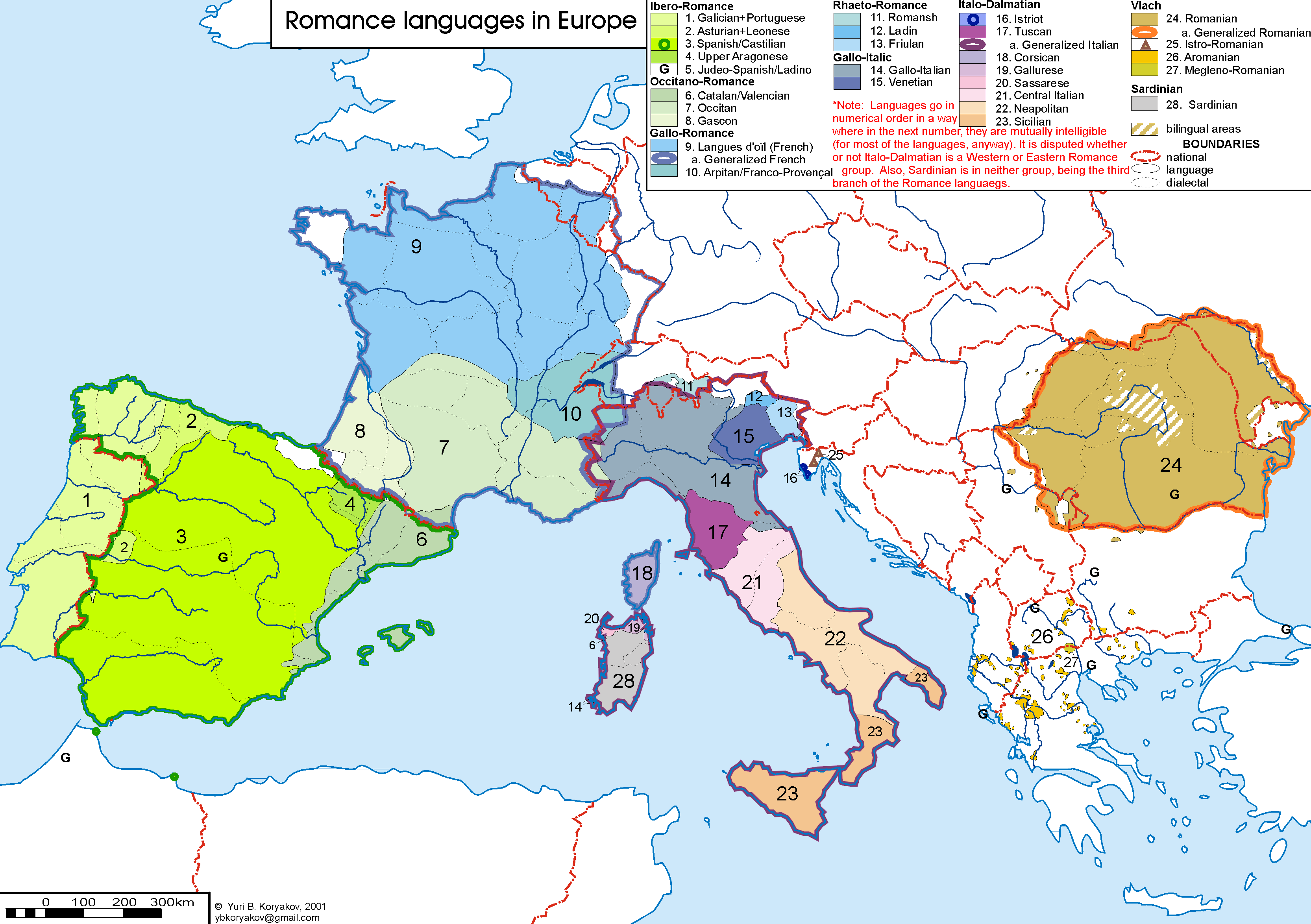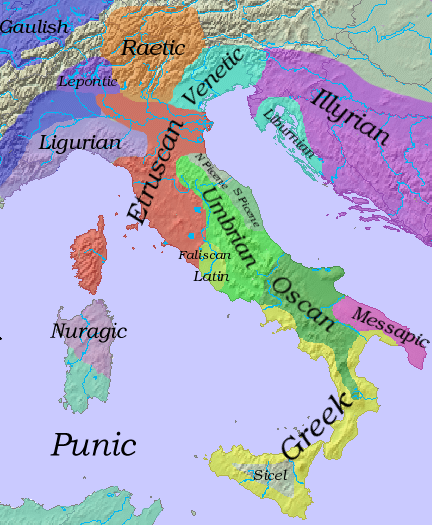|
Ibero-Romance
The Iberian Romance, Ibero-Romance or sometimes Iberian languages Iberian languages is also used as a more inclusive term for all languages spoken on the Iberian Peninsula, which in antiquity included the non-Indo-European Iberian language. are a group of Romance languages that developed on the Iberian Peninsula, an area consisting primarily of Spain, Portugal, Gibraltar, Andorra and French Catalonia. They are today more commonly separated into West Iberian, East Iberian ( Catalan/Valencian) and Mozarabic language groups. East Iberian's classification is a subject of ongoing scholarly debate, as some argue that the Occitano-Romance languages composed of Occitan along with the aforementioned two are better classified as Gallo-Romance languages. Evolved from the Vulgar Latin of Iberia, the most widely spoken Iberian Romance languages are Spanish and Portuguese, followed by Catalan-Valencian-Balear and Galician. These languages also have their own regional and local vari ... [...More Info...] [...Related Items...] OR: [Wikipedia] [Google] [Baidu] [Amazon] |
Occitano-Romance Languages
Occitano-Romance (; ; ) is a branch of the Romance language group that encompasses the Catalan/Valencian, Occitan languages and sometimes Aragonese, spoken in parts of southern France and northeastern Spain. The classification of Occitano-Romance languages within the wider Romance language family has been a subject of a long-standing debate due to its transitional nature in the Western Romance dialect continuum. The Gardiol language has been classified by Glottolog as a independent language in the Occitanic language family, but has also been classified as a dialect of Occitan. Extent The group covers the languages of the southern part of France (Occitania including Northern Catalonia), eastern Spain (Catalonia, Valencian Community, Balearic Islands, La Franja, Carche, Northern Aragon), together with Andorra, Monaco, parts of Italy ( Occitan Valleys, Alghero, Guardia Piemontese), and historically in the County of Tripoli and the possessions of the Crown of Aragon. The e ... [...More Info...] [...Related Items...] OR: [Wikipedia] [Google] [Baidu] [Amazon] |
Romance Languages
The Romance languages, also known as the Latin or Neo-Latin languages, are the languages that are Language family, directly descended from Vulgar Latin. They are the only extant subgroup of the Italic languages, Italic branch of the Indo-European languages, Indo-European language family. The five list of languages by number of native speakers, most widely spoken Romance languages by number of native speakers are: * Spanish language, Spanish (489 million): official language in Spain, Mexico, Equatorial Guinea, the Sahrawi Arab Democratic Republic, SADR, Cuba, Dominican Republic, Puerto Rico and most of Central America, Central and South America * French language, French (310 million): official in 26 countries * Portuguese language, Portuguese (240 million): official in Portugal, Brazil, Portuguese-speaking African countries, Portuguese-speaking Africa, Timor-Leste and Macau * Italian language, Italian (67 million): official in Italy, Vatican City, San Marino, Switzerland; mi ... [...More Info...] [...Related Items...] OR: [Wikipedia] [Google] [Baidu] [Amazon] |
Galician Language
Galician ( , ), also known as Galego (), is a Iberian Romance languages, Western Ibero-Romance language. Around 2.4 million people have at least some degree of competence in the language, mainly in Galicia (Spain), Galicia, an Autonomous communities of Spain, autonomous community located in northwestern Spain, where it has official status along with Spanish language, Spanish. The language is also spoken in some border zones of the neighbouring Spanish regions of Asturias and Castile and León, as well as by Galician migrant communities in the rest of Spain; in Latin America, including Argentina and Uruguay; and in Puerto Rico, the United States, Switzerland and elsewhere in Europe. Modern Galician is classified as part of the West Iberian languages, West Iberian language group, a family of Romance languages. Galician evolved locally from Vulgar Latin and developed from what modern scholars have called Galician-Portuguese. The earliest document written integrally in the ... [...More Info...] [...Related Items...] OR: [Wikipedia] [Google] [Baidu] [Amazon] |
Spanish Language
Spanish () or Castilian () is a Romance languages, Romance language of the Indo-European languages, Indo-European language family that evolved from the Vulgar Latin spoken on the Iberian Peninsula of Europe. Today, it is a world language, global language with 483 million native speakers, mainly in the Americas and Spain, and about 558 million speakers total, including second-language speakers. Spanish is the official language of List of countries where Spanish is an official language, 20 countries, as well as one of the Official languages of the United Nations, six official languages of the United Nations. Spanish is the world's list of languages by number of native speakers, second-most spoken native language after Mandarin Chinese; the world's list of languages by total number of speakers, fourth-most spoken language overall after English language, English, Mandarin Chinese, and Hindustani language, Hindustani (Hindi-Urdu); and the world's most widely spoken Romance language ... [...More Info...] [...Related Items...] OR: [Wikipedia] [Google] [Baidu] [Amazon] |
Portuguese Language
Portuguese ( or ) is a Western Romance language of the Indo-European language family originating from the Iberian Peninsula of Europe. It is the official language of Angola, Brazil, Cape Verde, Guinea-Bissau, Mozambique, Portugal and São Tomé and Príncipe, and has co-official language status in East Timor, Equatorial Guinea and Macau. Portuguese-speaking people or nations are known as Lusophone (). As the result of expansion during colonial times, a cultural presence of Portuguese speakers is also found around the world. Portuguese is part of the Iberian Romance languages, Ibero-Romance group that evolved from several dialects of Vulgar Latin in the medieval Kingdom of Galicia and the County of Portugal, and has kept some Gallaecian language, Celtic phonology. With approximately 250 million native speakers and 17 million second language speakers, Portuguese has approximately 267 million total speakers. It is usually listed as the List of languages by number of native speaker ... [...More Info...] [...Related Items...] OR: [Wikipedia] [Google] [Baidu] [Amazon] |
Western Romance Languages
Western Romance languages are one of the two subdivisions of a proposed subdivision of the Romance languages based on the La Spezia–Rimini Line. They include the Ibero-Romance and Gallo-Romance. Gallo-Italic may also be included. The subdivision is based mainly on the use of the "s" for pluralization, the weakening of some consonants and the pronunciation of " Soft C" as (often later ) rather than as in Italian and Romanian. Based on mutual intelligibility, Dalby counts thirteen languages: Portuguese, Spanish, Asturleonese, Aragonese, Catalan, Gascon, Provençal, Gallo-Wallon, French, Franco-Provençal, Romansh, Ladin and Friulian.David Dalby, 1999/2000, ''The Linguasphere register of the world’s languages and speech communities.'' Observatoire Linguistique, Linguasphere Press. Volume 2. Oxfor/ref> Some classifications include Italo-Dalmatian languages, Italo-Dalmatian; the resulting clade is generally called Italo-Western Romance. Other classifications pl ... [...More Info...] [...Related Items...] OR: [Wikipedia] [Google] [Baidu] [Amazon] |
Asturleonese
Asturleonese is a Romance language or language family spoken in northwestern Spain and northeastern Portugal, namely in the historical regions and Spain's modern-day autonomous communities of Asturias, northwestern Castile and León, Cantabria and Extremadura, and in Riudenore and Tierra de Miranda in Portugal. The name of the language is largely uncommon among its native speakers, as it forms a dialect continuum of mutually intelligible varieties and therefore it is primarily referred to by various regional glossonyms like ''Leonese'', '' Cantabrian'', ''Asturian'' or '' Mirandese'' (in Portugal). Extremaduran is sometimes included as well. Asturleonese has been classified by UNESCO as an endangered language, as the varieties are being increasingly replaced by Spanish and Portuguese. Phylogenetically, Asturleonese belongs to the West Iberian branch of the Romance languages that gradually developed from Vulgar Latin in the old Kingdom of León. The Asturleonese group is typ ... [...More Info...] [...Related Items...] OR: [Wikipedia] [Google] [Baidu] [Amazon] |
West Iberian Languages
West Iberian is a branch of the Ibero-Romance languages that includes the Castilian languages (Spanish, Judaeo-Spanish), Astur-Leonese ( Asturian, Leonese, Mirandese, Extremaduran (sometimes), Cantabrian),UNESCO Interactive Atlas of the World’s Languages in Danger where Cantabrian is listed in the Astur-Leonese linguistic group. and the descendants of Galician-Portuguese. Until a few centuries ago, th ... [...More Info...] [...Related Items...] OR: [Wikipedia] [Google] [Baidu] [Amazon] |
Andalusi Romance
Andalusi Romance, also called Mozarabic, refers to the varieties of Ibero-Romance that were spoken in Al-Andalus, the parts of the medieval Iberian Peninsula under Islamic control. Romance, or vernacular Late Latin, was the common tongue for the great majority of the Iberian population at the time of the Umayyad conquest in the early eighth century, but over the following centuries, it was gradually superseded by Andalusi Arabic as the main spoken language in the Muslim-controlled south. At the same time, as the northern Christian kingdoms pushed south into Al-Andalus, their respective Romance varieties (especially Castilian) gained ground at the expense of Andalusi Romance as well as Arabic. The final extinction of the former may be estimated to 1300 AD. The medieval Ibero-Romance varieties were broadly similar (with Castilian standing out as an outlier). Andalusi Romance was distinguished from the others not by its linguistic features primarily, but rather by virtue of bein ... [...More Info...] [...Related Items...] OR: [Wikipedia] [Google] [Baidu] [Amazon] |
Spain
Spain, or the Kingdom of Spain, is a country in Southern Europe, Southern and Western Europe with territories in North Africa. Featuring the Punta de Tarifa, southernmost point of continental Europe, it is the largest country in Southern Europe and the fourth-most populous European Union member state. Spanning across the majority of the Iberian Peninsula, its territory also includes the Canary Islands, in the Eastern Atlantic Ocean, the Balearic Islands, in the Western Mediterranean Sea, and the Autonomous communities of Spain#Autonomous cities, autonomous cities of Ceuta and Melilla, in mainland Africa. Peninsular Spain is bordered to the north by France, Andorra, and the Bay of Biscay; to the east and south by the Mediterranean Sea and Gibraltar; and to the west by Portugal and the Atlantic Ocean. Spain's capital and List of largest cities in Spain, largest city is Madrid, and other major List of metropolitan areas in Spain, urban areas include Barcelona, Valencia, Seville, ... [...More Info...] [...Related Items...] OR: [Wikipedia] [Google] [Baidu] [Amazon] |
Italic Languages
The Italic languages form a branch of the Indo-European languages, Indo-European language family, whose earliest known members were spoken on the Italian Peninsula in the first millennium BC. The most important of the ancient Italic languages was Latin, the official language of ancient Rome, which conquered the other Italic peoples before the Common Era, common era. The other Italic languages became Extinct language, extinct in the first centuries AD as their speakers were assimilated into the Roman Empire and Language shift, shifted to some form of Latin. Between the third and eighth centuries AD, Vulgar Latin (perhaps influenced by Substratum (linguistics), substrata from the other Italic languages) diversified into the Romance languages, which are the only Italic languages natively spoken today, while Literary Latin also survived. Besides Latin, the known ancient Italic languages are Faliscan language, Faliscan (the closest to Latin), Umbrian language, Umbrian and Oscan lan ... [...More Info...] [...Related Items...] OR: [Wikipedia] [Google] [Baidu] [Amazon] |
Aragonese Language
Aragonese ( ; in Aragonese) is a Romance languages, Romance language spoken in several dialects by about 12,000 people as of 2011, in the Pyrenees valleys of Aragon, Spain, primarily in the Comarca#Spain, comarcas of Somontano de Barbastro, Jacetania, Alto Gállego, Sobrarbe, and Ribagorza/Ribagorça. It is the only modern language which survived from medieval Navarro-Aragonese in a form distinct from Spanish language, Spanish. Historically, people referred to the language as ('talk' or 'speech'). Native Aragonese people usually refer to it by the names of its #Dialects, local dialects such as (from Valle de Hecho) or (from the Benasque Valley). History Aragonese, which developed in portions of the Ebro basin, can be traced back to the High Middle Ages. It spread throughout the Pyrenees to areas where languages similar to modern Basque language, Basque might have been previously spoken. The Kingdom of Aragon (formed by the counties of County of Aragon, Aragon, Sobrarbe an ... [...More Info...] [...Related Items...] OR: [Wikipedia] [Google] [Baidu] [Amazon] |





